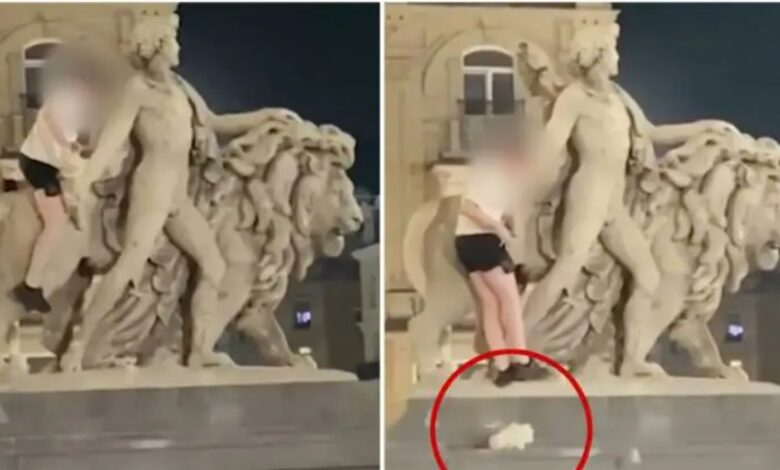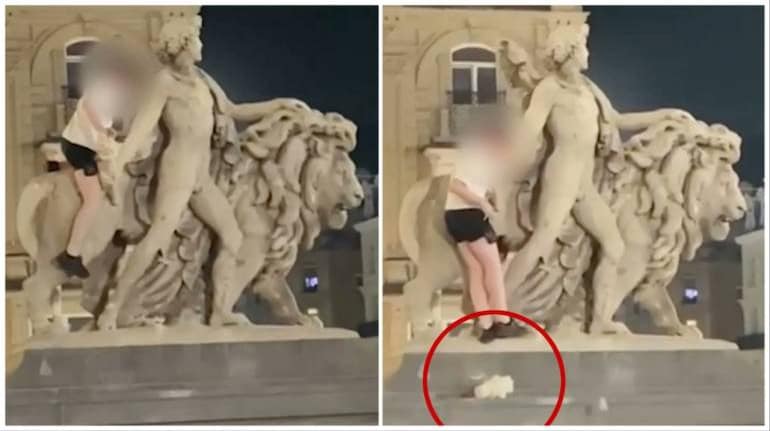Drunk Irish tourist tries to climb iconic statue in Belgium, causes nearly 16 lakh in damages

Drunk Irish tourist tries to climb iconic statue in Belgium, causes nearly 16 lakh in damages
The incident in question was undeniably an unusual and unfortunate episode that garnered attention both locally and internationally. The Brussels Stock Exchange, an architectural gem with a rich history, had recently undergone extensive restoration efforts, likely aimed at preserving its grandeur and cultural significance. Therefore, the occurrence of such an incident shortly after its reopening was particularly disheartening.
The tourist’s behavior, as captured on camera, revealed a series of reckless actions. Climbing a massive lion statue that guards the historic building may have seemed like a moment of audacious adventure for the individual involved, but it had severe consequences. In the process, a piece of the statue, possibly the torch it held, broke off, causing physical damage to the historical landmark.
Historical monuments and landmarks hold immense cultural and historical value. They are not just symbols of a city’s heritage but also representations of the collective history and identity of a nation. The Brussels Stock Exchange, being one such landmark, signifies the city’s financial and architectural history. The extensive restoration efforts were likely undertaken to ensure its preservation for generations to come.
Acts of vandalism or negligence around such landmarks not only pose physical risks to the individuals involved but also damage the shared cultural heritage. The repercussions of such incidents can be far-reaching, potentially leading to legal consequences for the individuals responsible and causing public outrage.
This incident serves as a poignant reminder of the importance of responsible tourism and behavior when visiting historical sites and monuments. Tourists should be aware of their surroundings and show respect for the places they visit. Responsible tourism not only safeguards these invaluable cultural treasures but also ensures that future generations can continue to appreciate and learn from them. It underscores the need for education and awareness campaigns to emphasize the significance of preserving our cultural heritage and the consequences of reckless behavior.
Such incidents can be distressing for both cultural heritage preservation and public safety. Historic monuments and statues often hold significant cultural and historical value, and any damage or vandalism can result in the loss of irreplaceable artifacts.

The fact that the tourist was found in police custody at a nearby fast-food establishment and expressed ignorance about the extent of the damage suggests that he may not have been fully aware of the consequences of his actions.
Efforts to preserve and protect cultural heritage sites are essential, and incidents like these highlight the importance of public education on respecting and safeguarding such sites, especially in popular tourist destinations. Authorities may also consider measures to prevent unauthorized access to sensitive areas around historic buildings and monuments to mitigate the risk of vandalism.
The estimated cost of restoring the damaged statue at the Brussels Stock Exchange, following the tourist’s reckless behavior, is a substantial $19,000 (approximately Rs 15.83 lakh). The authorities at the Brussels Stock Exchange are determined to hold the tourist accountable for the significant financial burden resulting from this incident.
Nel Vandevennet, the project manager responsible for overseeing the restoration effort, expressed deep disappointment over the incident. He highlighted the extensive restoration work that had recently been completed on the historic building, including the restoration of the two lion statues, which were in a state of disrepair. The incident involving the damaged statue is particularly disheartening for those involved in the restoration project, as they had hoped that these sculptures would be treated with the respect they deserve.
Efforts to restore cultural heritage sites and sculptures are often time-consuming and costly, and any damage caused to such sites can be a setback to preserving historical and artistic treasures. The incident serves as a reminder of the importance of public awareness and education regarding the value of cultural heritage and the need to protect and respect it. Authorities will likely pursue legal actions to address the financial and legal consequences of the tourist’s actions in an attempt to ensure accountability and deter future incidents of this nature.
The Brussels Stock Exchange, having recently reopened to the public following a major restoration, has ambitious plans to transform into a vibrant hub for exhibitions, performances, and a range of events. Visitors can already experience the convenience of an on-site cafe, and there are plans to introduce a restaurant in the near future. These additions aim to make the historic building more welcoming and appealing to the public.
Additionally, the Brussels Stock Exchange is home to the Belgian Beer World museum, which offers insights into the rich and diverse world of Belgian beer culture. However, it remains uncertain whether the Irish tourist had explored this museum during his visit.
The transformation of the Stock Exchange building into a multifunctional space for cultural and educational activities aligns with efforts to make historical sites more accessible and engaging for the public. It provides opportunities for locals and tourists alike to appreciate both the historical significance of the building and the cultural offerings it houses.




